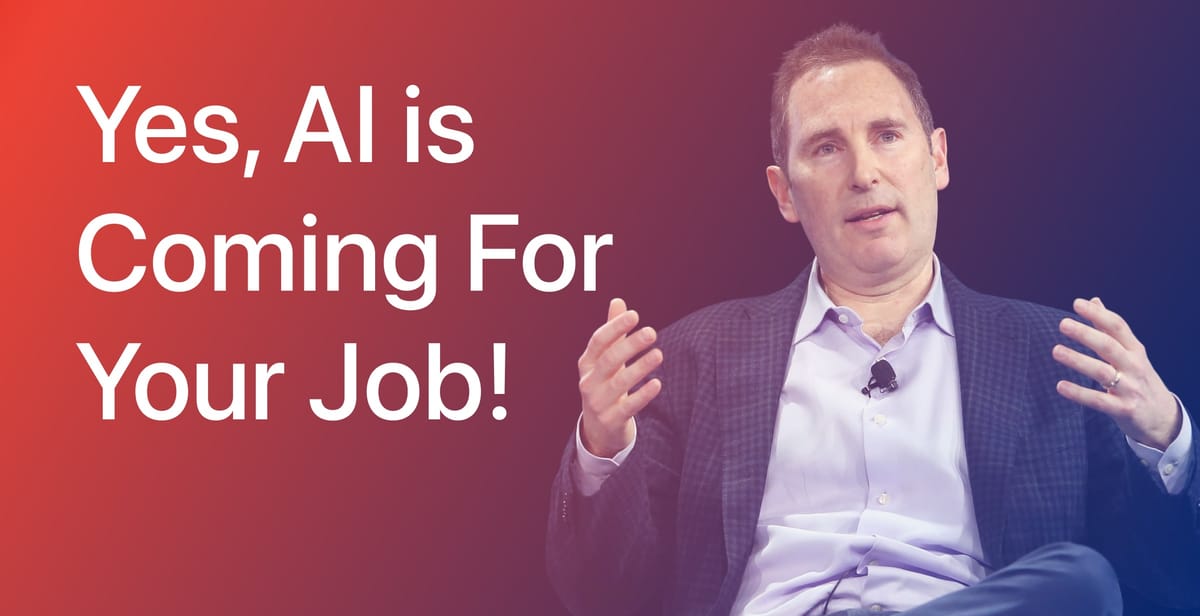
Amazon CEO Andy Jassy delivered an unusually candid message to employees Tuesday: the company's massive bet on artificial intelligence will cost jobs. In an internal memo shared with staff, Jassy said Amazon's rollout of generative AI and automated agents will "reduce our total corporate workforce" in the coming years as the technology makes entire categories of work obsolete.
Key Points:
- Amazon is building AI “agents” across every business line; 1,000+ projects are already live or in flight.
- Jassy says agents will trim corporate headcount while accelerating innovation.
- Flagship products include Alexa+, the Nova foundation models on Bedrock, and Amazon Q for developers.
"We will need fewer people doing some of the jobs that are being done today, and more people doing other types of jobs," Jassy wrote in the memo to employees today. "It's hard to know exactly where this nets out over time, but in the next few years, we expect that this will reduce our total corporate workforce as we get efficiency gains from using AI extensively across the company."
The memo comes as Amazon aggressively pushes into AI across every corner of its business—from the recently launched Alexa+ voice assistant that can book restaurants and order groceries autonomously, to AI-powered shopping tools used by tens of millions of customers. Jassy said the company now has more than 1,000 generative AI services and applications in development, calling it "still a small fraction of what we will ultimately build."
But Jassy's frank admission about workforce reduction stands out in an industry where executives typically emphasize AI's potential to "augment" rather than replace workers. While companies like Microsoft and Google have laid off thousands while investing heavily in AI, their leaders rarely draw such direct connections between the technology and job cuts.
The timing is particularly striking given Amazon's recent history of workforce reductions. The company has eliminated more than 27,000 corporate jobs since 2022, and reports indicate another 14,000 managerial positions are on the chopping block—cuts that could save Amazon between $2.1 billion and $3.6 billion annually. Those layoffs were framed around economic uncertainty and organizational efficiency, but Jassy's memo suggests AI-driven automation will be a major factor going forward.
Jassy tried to balance the sobering reality with enthusiasm for AI's potential, describing generative AI as a "once-in-a-lifetime" technology that will "completely change what's possible for customers and businesses." He urged employees to "be curious about AI" and experiment with the tools, warning that those who embrace the change will be "well-positioned to have high impact" while implying others may not survive the transition.
The CEO pointed to Amazon's internal use of AI as evidence of its transformative power. The company is using AI to optimize warehouse operations, rebuild its customer service chatbot, and improve product listings. Jassy claimed these applications have already improved "cost to serve and delivery speed" while making work more efficient.
Amazon's AI strategy centers heavily on what Jassy calls "agents"—AI systems that can complete complex tasks autonomously rather than just answering questions. He envisions "billions of these agents, across every company and in every imaginable field" that will handle everything from research and coding to scheduling and shopping.
The centerpiece of this vision is Alexa+, Amazon's revamped voice assistant that launched in February with generative AI capabilities. Unlike the original Alexa that handled simple commands, Alexa+ can navigate websites, make reservations, and complete multi-step tasks without human supervision. It's free for Prime members or $20 per month for others—Amazon's attempt to finally monetize its voice assistant business after years of losses.
For Amazon's workforce, Jassy's message was clear: adapt or be left behind. He encouraged employees to attend AI workshops, experiment with tools, and figure out "how to get more done with scrappier teams." The memo specifically called out his early days at Amazon in 1997, when "leaner teams" accomplished more with fewer resources—a not-so-subtle hint about the company's direction.
The frank discussion of AI-driven job cuts reflects a broader shift in how tech companies are approaching automation. While earlier waves of tech eliminated blue-collar manufacturing jobs, today's AI targets white-collar knowledge work that was previously considered safe from automation. Software engineers who were recently asked to integrate AI tools into their workflows are now finding themselves replaced by those same systems.

Amazon isn't alone in this transformation. Microsoft, Google, and other tech giants have announced thousands of layoffs while pouring billions into AI development. A recent analysis found over 40% of layoffs in Washington state specifically targeted software engineers, many of whom had been instructed to adopt AI tools just months before losing their jobs.
For Amazon's 1.56 million employees worldwide, Jassy's memo serves as both warning and rallying cry. The company that once proudly operated like a startup is betting everything on AI to maintain that scrappy edge—even if it means fewer people along for the ride.


